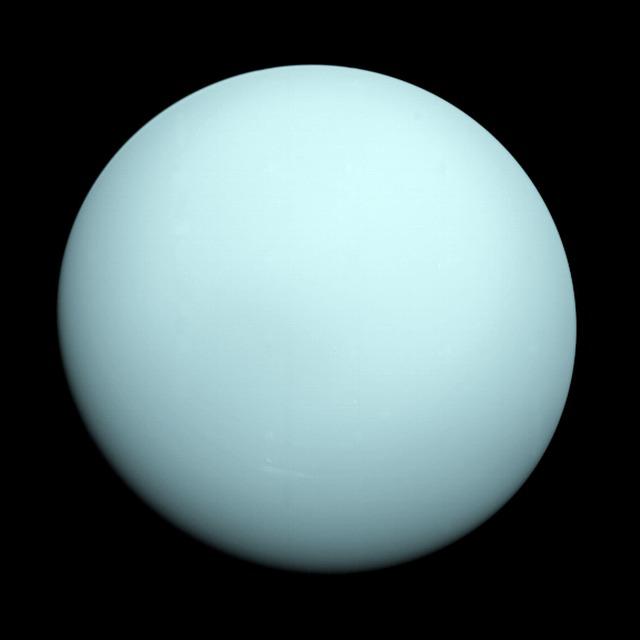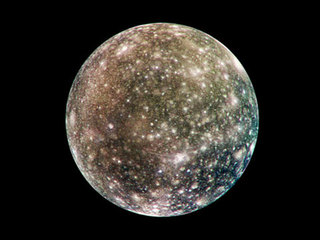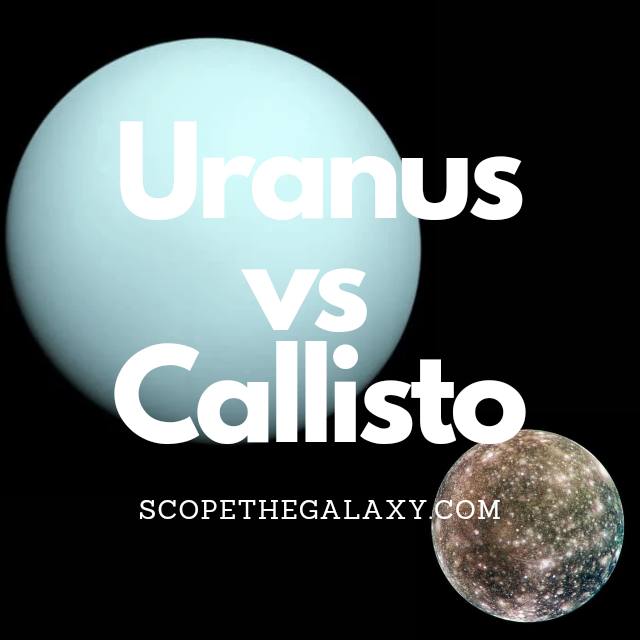*This post may contain affiliate links. This means we may make a commission if you purchase an item using one of our links*
The main differences between Uranus and Callisto is that Uranus is a gas based ice giant whilst Callisto is one of Jupiter’s moons, Callisto is the 3rd largest moon whilst Uranus is the 3rd largest planet, Uranus has the most extreme axial tilt within our solar system at 98° whilst Callisto’s is 0° and it takes Uranus 84 years to orbit the Sun whilst Callisto does so in 12 years.
There are a variety of other differences between the two so, continue reading for a more detailed look at each celestial body along with an in-depth breakdown of their similarities and differences.
What Is The Planet Uranus?
Table of Contents

Uranus is the 7th farthest planet from the Sun and the 3rd largest planet in our solar system, coming in at a diameter of 50,724 km. This means that roughly 63 Earth’s could fit inside this ice giant.
In regards to why this cyan blue planet is referred to as an ice giant, it’s down to it’s composition. Uranus is made mostly of methane, ammonia and water with its atmosphere mostly consisting of hydrogen and helium, much like the Sun, and the other giant planets in our solar system.
Due to its distance from the Sun, it takes Uranus 84 years to complete one orbit our central star, whereas it’s axial rotation is much faster than even our Earth at 17 hours per rotation.
As a result of its distance from the Sun, ice based composition and faster rotation levels, Uranus is far from an ideal place to live in let alone have the potential to support life.
Its base temperature is generally a chilling -190 to -200 degrees Celsius and its rocky core, although hot, is still on the cooler side for a large planet sitting around the 5,000 degrees Celsius range.
The planet’s winds are also very fast often hitting 900 km/h, which is roughly twice that of Earth’s most powerful turbulent wind speeds.
In regards to the moons surrounding this cyan planet, we’ve discovered 27 small ones orbiting it. Furthermore, it has 13 rings surrounding it which also means Uranus has the most abundant collection of rings surrounding in our solar system, which is even more than Saturn.
One of the Uranus’ most unique features would include the manner in which it rotates around its axis. As opposed to the slightly angled rotation that the likes of Earth, Saturn and most other planets display, Uranus’ axis is positioned at a 98 degree angle.
What this means is this ice giant completes an axial rotation on its side as opposed to the relatively up straight positioning of most of the other planets in our solar system.
What Is The Moon Callisto?

Callisto is one of the large moons orbiting Jupiter, the outermost of the Galilean moons, first discovered on 7th January 1610. The surface of this icy world is frozen, but scientists believe an underground ocean could reside beneath the ice.
Even if there’s water on Callisto, it won’t necessarily hold life because the surface is so old. Scientists will need to conduct more research into the moon before determining whether this is a likely possibility.
The ESA’s JUICE (Jupiter Icy Moon Explorer) mission is focused on the three ice moons of Jupiter. It is expected to arrive in 2030 and will focus on learning more about the environment of each, as well as their potential for hosting life.
Scientists estimate that Callisto is around 4.5 billion years old (the same age as Jupiter), and its average distance from the Sun is approximately 778 million km. It has a diameter of 4,820.6km, which makes it similar in size to the planet Mercury, and the average temperature is a frigid minus 139.2 degrees Celsius.
Callisto takes seven days to orbit its planet at an average distance of 1,880,000km, and it is tidally locked, meaning the same side of it always faces Jupiter. But this moon experiences less tidal influence than the other Galilean moons because it lies in the orbit of Jupiter’s primary radiation belt.
The name of this moon is derived from the stories of Greek myth. Callisto was the nymph who had an affair with Zeus, the King of the Gods. Upon hearing this news, Zeus’ wife Hera turned Callisto into a star and placed her in the Ursa Major constellation. Interestingly, every moon of Jupiter is named after a Greek figure who Zeus seduced.
Callisto may be the third biggest moon and similar in size to the planet Mercury, but it only has a mass of 107,593,737,963.819 billion kg. That may sound like a lot, but it’s only ⅓ the mass of the similarly sized Mercury.
You may wonder why scientists classify Callisto as a “moon” rather than a planet if it’s almost the same size as Mercury. The reason is simple; planets must orbit the sun, but Callisto orbits one of the planets.
The composition of this frigid world is around 60% rock and iron and 40% ice. The moon has roughly equal amounts of rock and ice, plus the potential for water below the surface. There are also traces of carbon dioxide, organic compounds, and silicates.
This moon is one of the oldest landscapes in the Milky way and the most heavily cratered body in our system. However, scientists believe this could now be a “dead” moon as there are no longer any signs of volcanism or plate tectonics on its surface.
How Are Uranus And Callisto Similar?
Uranus and Callisto do share a few similar features, which in this case includes the following:
- Both are a spherical shape.
- Both have a hotter core.
- Both are part of the same solar system.
- Neither have tectonic plates.
- Both orbit another object.
Differences Between Uranus And Callisto
As for the differences between the two, they include the below:
- Uranus is bigger with a diameter of 50,724 compared to Callisto’s diameter of 4,820.6km.
- Uranus has a magnetosphere whilst Callisto does not.
- Uranus has 27 moons orbiting it whilst Callisto has 0 objects orbiting it.
- Callisto orbits Jupiter in an elliptical pattern whilst Uranus orbits the Sun in a less drastic elliptical pattern.
- Callisto is tidally locked to Jupiter whilst Uranus isn’t tidally locked to any other object.
- Uranus has an atmosphere composed of hydrogen, helium and methane whilst Callisto has a very thin carbon dioxide based exosphere.
- Callisto is one of the most heavily catered entities in our solar system where it has 142 named craters with a lot more smaller one scattered throughout the moon whilst Uranus is an ice based gas giant therefore, it doesn’t have solid surface for craters to form on.
- A day on Callisto takes 17 days whilst Uranus completes a day in 17 hours.
- Callisto’s density is 1.83 g/cm³ whilst Uranus’ is 1.27 g/cm³.
- In regards to axial tilt, Uranus has the most drastic one at 98 degrees whilst Callisto’s is practically 0 degrees.
- Uranus has an average temperature of -190 to -200 degrees Celsius whilst Callisto’s temperature is -139.2 degrees Celsius.
- As for mass, Callisto’s is 1.07 x 10^23 kg whilst Uranus’ mass is 8.681 × 10^25 kg.
- Uranus is an ice based gas giant whilst Callisto is a low density terrestrial entity.
- Uranus has the most rings amongst all the planets at 13 whilst Callisto has 0.
- Uranus has a gravitational strength of 8.87 m/s² whilst Callisto’s is 1.236 m/s².
- Uranus orbits the Sun in 84 years whilst Callisto orbits it in 12 years.
Summary
Uranus and Callisto do have the odd few commonalities such as the fact both are part of the same solar system, orbit another object larger than them and have a hotter centralised core but, their differences definetly outweigh their similarities.
Whether it be in regards to the length of their days, mass, size, orbital cycle, their physical composition and simply how they function, the two are worlds apart.

